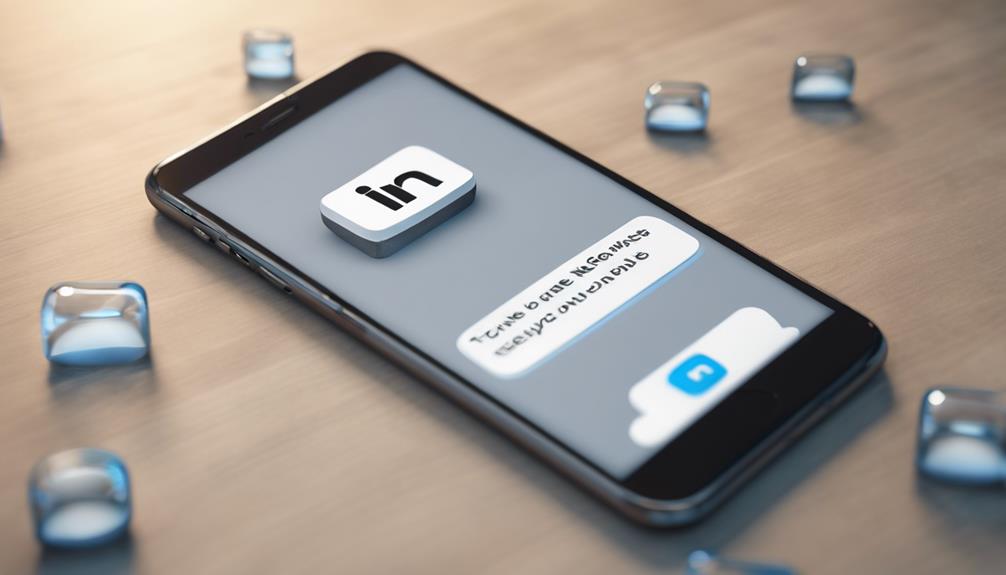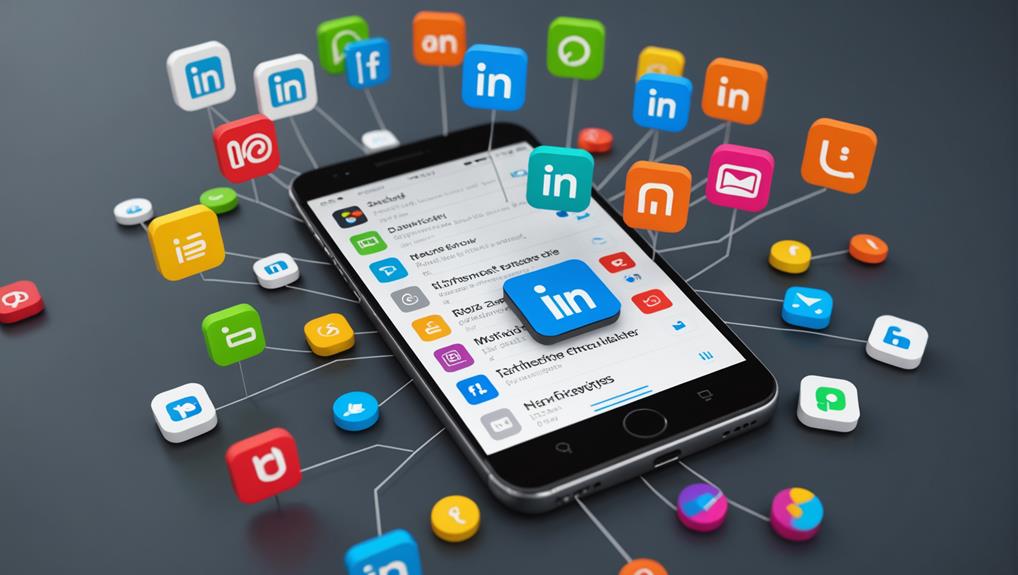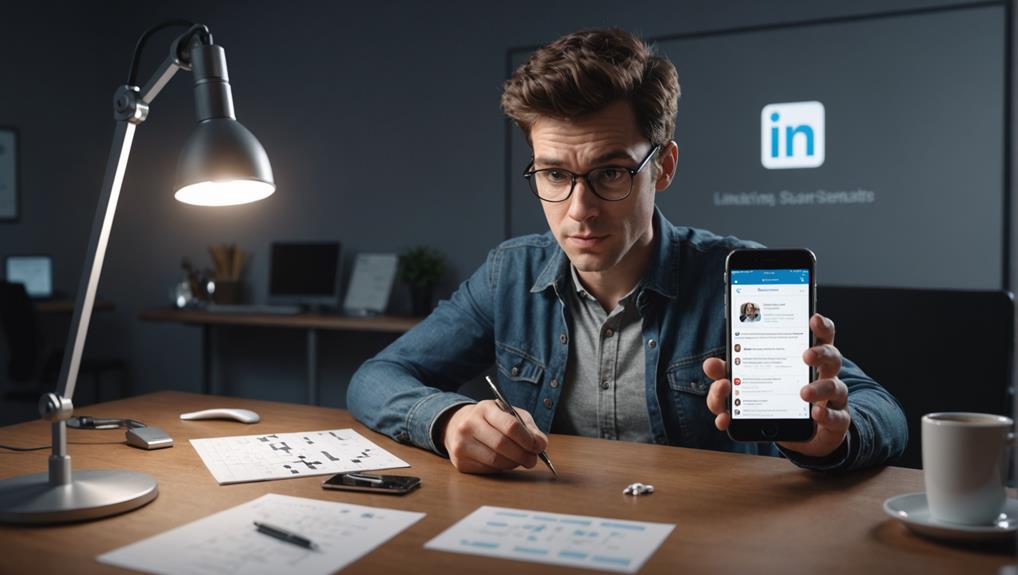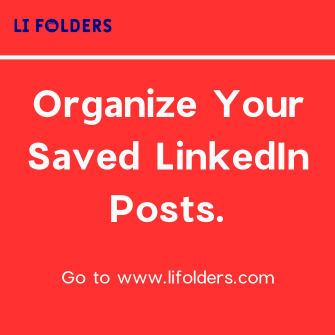
When you see a grey check mark next to your LinkedIn message, it means your message has been sent but hasn't been delivered to the recipient yet. This check mark is an initial step in the communication process, indicating that your message is on its way but still awaiting confirmation of delivery. It's a reminder to be patient as it doesn't confirm when or if the recipient will open it. As you navigate your networking efforts, understanding these symbols helps in managing your expectations and maintaining a proactive stance in your professional interactions, waiting the shift to a blue check mark, which signifies more interaction and engagement.
Understanding LinkedIn Notifications

LinkedIn notifications keep you in the loop about interactions and updates relevant to your profile and activity. They're your digital nod, letting you know when others engage with your content or make moves that might interest you. Imagine them as a friendly tap on the shoulder, keeping you connected to your professional community, ensuring you don't miss out on opportunities to interact or gather insights.
You'll see these alerts pop up for various reasons—whether someone likes your post, comments on your article, or requests to connect, it's all there. Each notification is an invitation to engage, to step back into the conversation and strengthen your network. When you respond to these prompts, you're not just reacting; you're nurturing relationships and fostering a sense of community.
These little red flags are more than just reminders; they are your gateway to maintaining relevance in your field. Staying active and responsive makes you visible and valuable to your network. So next time you get a notification, view it as a chance to reaffirm your place and purpose within your professional circle. Engage, interact, and belong—it's all at your fingertips.
The Significance of Grey Checks
Now, let's explore the significance of grey checks in your LinkedIn messages. When you see that grey check, it's not just a symbol; it's a nod of acknowledgment. It means your message has been successfully sent but hasn't yet been read. This little grey check is your first step in connecting, a subtle but crucial part of your networking journey.
Think of it as knocking on someone's door. You've made your move, shown initiative, and now the ball is in their court. It's a moment filled with possibilities. Will they open the door? Will this be the start of a meaningful professional relationship? This anticipation is a fundamental part of the LinkedIn experience, reminding you that you're part of a larger community, actively seeking to engage and expand your professional circle.
Grey Vs. Blue Check Marks

Understanding the difference between grey and blue check marks can help you gauge the status of your messages more accurately. On LinkedIn, these small symbols are more than just decorative; they're crucial indicators of your communication's progress within your professional circle.
The grey check mark appears when you've sent a message. It's LinkedIn's way of letting you know that your message is on its way through the digital ether. Think of it as a nod from the platform, confirming, "Message received, and it's in transit!" This simple grey symbol assures you that you've done your part in reaching out.
On the other hand, the blue check mark steps in when your message not only reaches the recipient's inbox but is also opened by them. It's a subtle, yet powerful way of knowing you're not just speaking into the void. That your words have caught the attention of someone else, making you feel more connected and less isolated in the vast professional network.
Both these indicators are your allies in navigating the intricate web of professional interactions, ensuring that you're not left wondering about your message's fate. They help bridge the gap between sending a message and establishing a meaningful connection.
Timing and Message Status
Let's explore how the timing of sending and receiving messages impacts their status on LinkedIn. You've probably noticed that when you send a message, the status changes over time, reflecting how far it's gotten in reaching the other person. Initially, you'll see a grey check mark next to your message. This simply means that your message has been sent from your side but hasn't been delivered to the recipient's device yet.
Timing is crucial here. If you're messaging someone in a different time zone, or during off hours, it could take longer for that grey check to turn into a blue one, which signifies that the message has been delivered. This gap can sometimes cause worry or uncertainty—did they get the message? Are they ignoring me?—but remember, it's just about timing.
The pace at which people respond can vary widely too. Some might check LinkedIn regularly, while others may only log in occasionally. This affects when that blue tick might finally turn into a double blue tick, indicating they've read your message. Understanding this can help you feel more connected and less isolated in your professional interactions, knowing it's a shared experience.
Implications for LinkedIn Users

As a LinkedIn user, recognizing these message status symbols can streamline your communication and set realistic expectations for replies. Understanding the grey check mark is particularly crucial. It indicates that your message has been sent but not yet delivered. This knowledge helps you feel connected to the network's pulse, ensuring you're not left wondering why a response hasn't been forthcoming.
This small but significant symbol also fosters a sense of community. You're part of a vast network where everyone deals with similar communication signals. Realizing that others are navigating the same system can make you feel less isolated, especially when connections don't respond immediately.
Moreover, this insight allows you to manage your networking efforts more effectively. You won't waste time anxiously awaiting feedback on a message that hasn't yet reached its recipient. Instead, you can use that time to engage with other connections or refine your messaging strategy.
Embrace this feature as a tool for better understanding how your communications are handled within LinkedIn. It's about being informed and proactive in your professional interactions, ensuring that you remain an integral part of your industry's community, constantly fostering meaningful connections.
Best Practices for Messaging
To optimize your LinkedIn messaging, it's crucial to follow a few key guidelines. First, personalize your messages. When you reach out, mention something specific about the person's profile or shared experiences. This shows you're genuinely interested and not just blasting out generic requests.
Keep your messages concise and to the point. You're often connecting with busy professionals, so respect their time. A brief, clear message that gets straight to the point is more likely to be read and responded to.
Always maintain a professional tone, even if you're feeling casual. This platform is a professional space, and your communication should reflect that. However, don't be afraid to let your personality shine through. This makes your interactions more memorable and helps you stand out.
Lastly, remember to follow up. If you haven't received a response after a week or two, it's okay to send a polite follow-up message. This can demonstrate your enthusiasm and commitment without being pushy.
Troubleshooting Common Issues

You might encounter a few common issues when using LinkedIn messages, but most are easily fixable. One common problem is not receiving notifications for new messages. First, check your notification settings in LinkedIn to ensure they're set to alert you. It's also a good idea to verify your email settings, as sometimes notifications can be directed there instead.
Another issue could be messages not sending. This usually happens when there's a glitch in the network connection. Try refreshing your page or checking your internet connectivity. Sometimes, just waiting a few moments and trying again can solve the problem.
If you're finding that the grey check mark remains without changing, remember it only turns blue once the recipient has read your message. If it stays grey, they might not have opened it yet. Patience is key here; not everyone checks LinkedIn frequently.
Lastly, if LinkedIn itself seems buggy or unresponsive, it might be worthwhile to clear your browser's cache or try accessing the site from a different browser or device. This can often resolve unexpected glitches.
Enhancing Professional Communication
Enhancing your professional communication on LinkedIn can significantly boost your networking effectiveness. When you're reaching out to others, remember that every message reflects who you are. You're not just building connections; you're fostering potential partnerships. It's crucial to personalize your messages; a generic greeting won't make you stand out. Show that you're genuinely interested in the person behind the profile.
Your tone matters too. It's like the handshake in a virtual meeting. Be professional yet approachable, balancing formality with a touch of personal warmth. This balance helps you resonate more with others, making them feel valued and understood.
Also, be concise but thorough. Don't just skim the surface. Dive a bit deeper into subjects that matter to your connection. Discuss common interests or mutual goals. It's about finding that common ground that turns a simple connection into a meaningful relationship.
Lastly, always follow up. If someone has taken the time to respond, acknowledge their message promptly. This not only shows your professionalism but also that you value the connection. Remember, every interaction on LinkedIn is an opportunity to reinforce your presence in your professional community.
Conclusion
You've got a handle on LinkedIn's grey check marks now! Remember, they're just a nudge that your message is sent but not yet read. Don't confuse them with blue checks, which mean your message has been seen. Use this insight to tailor your follow-ups wisely and enhance your professional communication. If issues arise, revisit these tips and adjust as needed. Keep your messages clear and engaging to make the most of your LinkedIn connections!






